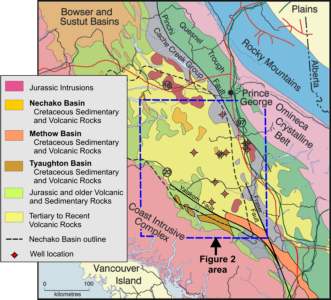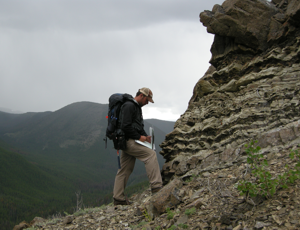Summary
Accurate assessment of the petroleum potential of the Nechako Basin hinges on a comprehensive understanding of the basin architecture developed within Cretaceous strata, which represent the most prospective targets in the subsurface.
 Modeling the subsurface facies distribution of these Cretaceous strata requires detailed stratigraphic analysis of coeval, laterally adjacent strata exposed along the basin margins.
Modeling the subsurface facies distribution of these Cretaceous strata requires detailed stratigraphic analysis of coeval, laterally adjacent strata exposed along the basin margins.
This three-year project provides a detailed analysis of the Cretaceous stratigraphy of the northern Methow Basin, including the Lower Cretaceous Jackass Mountain Group (JMG), which is probably the best candidate for a major reservoir system in the såubsurface of the Nechako Basin. Additional examination of other early Cretaceous sedimentary units of the south central Nechako Basin, commonly termed Skeena Group or "Skeena Assemblage" will help resolve the confusion in terminology for these early Cretaceous units, which may largely represent northern continuations of Methow Basin deposystems.
The JMG and associated strata include thick (100's m), laterally extensive (10's km) marine sandstone successions that overlie and interfinger with marine mudstones. Previous studies of the JMG and bounding successions have been primarily "first order" stratigraphic assessments commonly associated with government regional mapping projects. This study will significantly expand and supersede earlier studies and emphasize more detailed stratigraphic analysis.

This investigation provides comprehensive sedimentologic and stratigraphic analysis of Cretaceous strata in the southern part and along the southern margin of the Nechako Basin, including detailed petrologic analysis (with porosity/permeability estimates), provenance studies (detrital mica and zircon, Nd analysis of fine-grained units, geochemistry of conglomerate clasts), biostratigraphic studies and assessment of hydrocarbon reservoir rock potential. Integration of these data sets will be the basis for a comprehensive model of basin evolution during Early Cretaceous time, which should in turn allow prediction of regional changes in facies associations into the subsurface of the Nechako Basin.